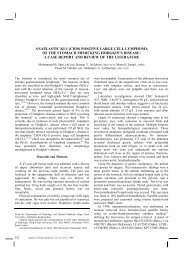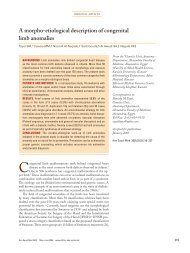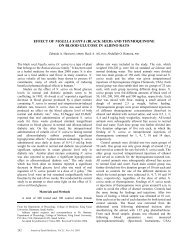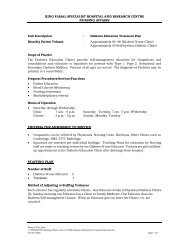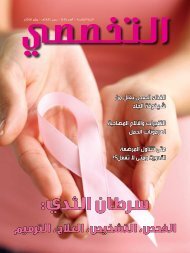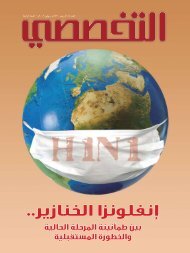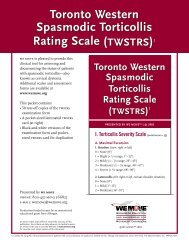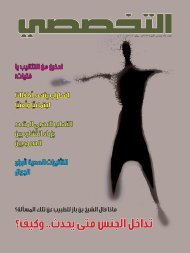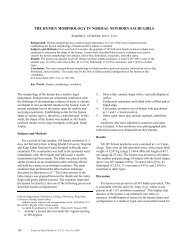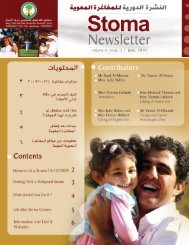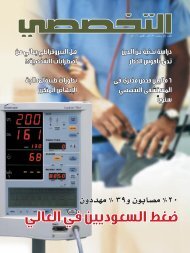Finding Truth from the Medical Literature: How to Critically Evaluate ...
Finding Truth from the Medical Literature: How to Critically Evaluate ...
Finding Truth from the Medical Literature: How to Critically Evaluate ...
You also want an ePaper? Increase the reach of your titles
YUMPU automatically turns print PDFs into web optimized ePapers that Google loves.
Prim Care Clin Office Pract<br />
33 (2006) 839–862<br />
<strong>Finding</strong> <strong>Truth</strong> <strong>from</strong> <strong>the</strong> <strong>Medical</strong><br />
<strong>Literature</strong>: <strong>How</strong> <strong>to</strong> <strong>Critically</strong><br />
<strong>Evaluate</strong> an Article<br />
William F. Miser, MD, MA<br />
Department of Family Medicine, The Ohio State University College of Medicine,<br />
2231 North High Street, Room 203, Columbus, OH 43201, USA<br />
With Internet access available <strong>to</strong> all, patients are increasingly gaining<br />
access <strong>to</strong> medical information, and <strong>the</strong>n looking <strong>to</strong> <strong>the</strong>ir primary care physician<br />
for its interpretation. Gone are <strong>the</strong> days when what <strong>the</strong> physician says<br />
goes unchallenged by a patient. Our society is inundated with medical advice<br />
and contrary views <strong>from</strong> <strong>the</strong> newspaper, radio, television, popular lay journals,<br />
and <strong>the</strong> Internet, and physicians are faced with <strong>the</strong> task of ‘‘damage<br />
control.’’ Patients are searching for answers even before <strong>the</strong>y come <strong>to</strong> <strong>the</strong><br />
office, and are bringing with <strong>the</strong>m articles <strong>the</strong>y have downloaded <strong>from</strong> <strong>the</strong><br />
Internet for interpretation.<br />
Primary care physicians also encounter an ‘‘information jungle’’ when it<br />
comes <strong>to</strong> <strong>the</strong> medical literature [1,2]. The amount of information available<br />
can be overwhelming [3]. There were 682,121 articles recorded in Pub<br />
MED in 2005. If clinicians, trying <strong>to</strong> keep up with <strong>the</strong> medical literature,<br />
were <strong>to</strong> read two articles per day, in just 1 year <strong>the</strong>y would be over nine centuries<br />
behind in <strong>the</strong>ir reading!<br />
Despite <strong>the</strong> volume of medical literature, fewer than 15% of all articles<br />
published on a particular <strong>to</strong>pic are useful for clinical practice [4]. Most articles<br />
are not peer-reviewed, are sponsored by those with commercial interests,<br />
or arrive free in <strong>the</strong> mail (<strong>the</strong> so-called ‘‘throwaways’’). Even articles<br />
published in <strong>the</strong> most prestigious journals are far <strong>from</strong> perfect. Analyses<br />
of clinical trials published in a wide variety of journals have identified large<br />
deficiencies in design, analysis, and reporting; although improving over<br />
time, <strong>the</strong> average quality score of clinical trials over <strong>the</strong> past 2 decades is<br />
less than 50% [5–7]. This has resulted in diagnostic tests and <strong>the</strong>rapies becoming<br />
established as a routine part of practice before being rigorously<br />
E-mail address: miser.6@osu.edu<br />
0095-4543/06/$ - see front matter Ó 2006 Elsevier Inc. All rights reserved.<br />
doi:10.1016/j.pop.2006.09.012<br />
primarycare.<strong>the</strong>clinics.com
840 MISER<br />
evaluated; which has led <strong>to</strong> <strong>the</strong> widespread use of tests with uncertain<br />
efficacy, and treatments that are ei<strong>the</strong>r ineffective or that may do more<br />
harm than good [8]. A good recent example is <strong>the</strong> widespread use of hormonal<br />
replacement <strong>the</strong>rapy <strong>to</strong> prevent cardiovascular disease, dementia,<br />
and o<strong>the</strong>r chronic diseases; <strong>the</strong> Women’s Health Initiative studies showed<br />
that this practice did more harm than good [9].<br />
Although several excellent services are available <strong>to</strong> physicians that sift<br />
through and critically assess <strong>the</strong> medical literature, <strong>the</strong>y are not helpful<br />
when a patient brings in <strong>the</strong> latest article that is ‘‘hot off <strong>the</strong> presses.’’<br />
Thus, physicians must have basic skills in judging <strong>the</strong> validity and clinical<br />
importance of <strong>the</strong>se articles. The two major types of articles (Fig. 1) found<br />
in <strong>the</strong> medical literature are those that (1) report original research (analytic,<br />
primary studies), and (2) those that summarize or draw conclusions <strong>from</strong><br />
original research (integrative, secondary studies). Primary studies can be<br />
ei<strong>the</strong>r experimental (an intervention is made) or observational (no intervention<br />
is made). This article provides an overview of a systematic, efficient, and<br />
effective approach <strong>to</strong> <strong>the</strong> critical review of original research. This information<br />
is pertinent <strong>to</strong> physicians no matter <strong>the</strong> clinical setting. Because of space<br />
limitations, this article cannot cover everything in exhaustive detail, and <strong>the</strong><br />
reader is encouraged <strong>to</strong> refer <strong>to</strong> <strong>the</strong> suggested readings in Appendix 1 for<br />
fur<strong>the</strong>r assistance.<br />
<strong>Medical</strong> <strong>Literature</strong><br />
Primary (Analytic) Studies<br />
those that report original research<br />
Secondary (Integrative) Studies<br />
those that draw conclusions<br />
<strong>from</strong> original research<br />
meta-analysis<br />
systematic review<br />
non-systematic review<br />
edi<strong>to</strong>rial, commentary<br />
practice guideline<br />
decision analysis<br />
economic analysis<br />
Experimental<br />
an intervention is made or<br />
variables are manipulated<br />
experiment<br />
randomized controlled trial<br />
non-randomized controlled trial<br />
Observational<br />
no intervention is made and<br />
no variables are manipulated<br />
cohort<br />
case-control<br />
cross-sectional<br />
descriptive, surveys<br />
case reports<br />
Fig. 1. The major types of studies found in <strong>the</strong> medical literature.
CRITICAL EVALUATION OF MEDICAL LITERATURE<br />
841<br />
Critical assessment of an original research article<br />
It is important for clinicians <strong>to</strong> master <strong>the</strong> ability <strong>to</strong> critically assess an<br />
original research article if <strong>the</strong>y are <strong>to</strong> apply ‘‘evidence-based medicine’’ <strong>to</strong><br />
<strong>the</strong> daily clinical problems <strong>the</strong>y encounter. Most busy clinicians, however,<br />
do not have <strong>the</strong> hours required <strong>to</strong> fully critique an article; <strong>the</strong>y need a brief<br />
and efficient screening method that allows <strong>the</strong>m <strong>to</strong> know if <strong>the</strong> information<br />
is valid and applicable <strong>to</strong> <strong>the</strong>ir practice. By applying <strong>the</strong> techniques offered<br />
here, one can approach <strong>the</strong> literature confidently and base clinical decisions<br />
on ‘‘evidence ra<strong>the</strong>r than hope’’ [10].<br />
This approach is modified and adapted <strong>from</strong> several excellent sources.<br />
The Department of Clinical Epidemiology and Biostatistics at McMaster<br />
University in Hamil<strong>to</strong>n, Ontario, Canada in 1981 published a series of useful<br />
guides <strong>to</strong> help <strong>the</strong> busy clinician critically read clinical articles about<br />
diagnosis, prognosis, etiology, and <strong>the</strong>rapy [11–15]. These guides have subsequently<br />
been updated and expanded <strong>to</strong> focus more on <strong>the</strong> practical issues<br />
of first finding pertinent articles and <strong>the</strong>n validating (believing) and applying<br />
<strong>the</strong> information <strong>to</strong> patient care (see Appendix 1) [10]. The recommendations<br />
<strong>from</strong> <strong>the</strong>se users’ guides form <strong>the</strong> foundation upon which techniques developed<br />
by Slawson and colleagues are modified and added [1,2]. With an article<br />
in hand, <strong>the</strong> process involves three steps: (1) conduct an initial validity<br />
and relevance screen, (2) determine <strong>the</strong> intent of <strong>the</strong> article, and (3) evaluate<br />
<strong>the</strong> validity of <strong>the</strong> article based on its intent.<br />
Step one: conduct an initial validity and relevance screen<br />
The first step when looking at an article is <strong>to</strong> ask, ‘‘Is this article worth<br />
taking <strong>the</strong> time <strong>to</strong> review in depth’’ This can be answered within a few seconds<br />
by asking six simple questions (Appendix 2). A ‘‘s<strong>to</strong>p’’ or ‘‘pause’’ answer<br />
<strong>to</strong> any of <strong>the</strong>se questions should prompt one <strong>to</strong> seriously consider<br />
whe<strong>the</strong>r time should be spent <strong>to</strong> critically assess <strong>the</strong> article.<br />
Is <strong>the</strong> article <strong>from</strong> a peer-reviewed journal<br />
Most national and specialty journals published in <strong>the</strong> United States are<br />
peer-reviewed; if in doubt, this answer can be found in <strong>the</strong> journal’s ‘‘Instructions<br />
for Authors’’ section. Typically, journals sent <strong>to</strong> clinicians unsolicited<br />
and free of charge are known as ‘‘throwaway’’ journals. These<br />
journals, although attractive in appearance, are not peer-reviewed, but instead<br />
are often geared <strong>to</strong>ward generating income <strong>from</strong> advertising, and consist<br />
of ‘‘expert opinions’’ [3,10].<br />
Articles published in <strong>the</strong> major peer-reviewed journals have already undergone<br />
an extensive process <strong>to</strong> sift out flawed studies and <strong>to</strong> improve <strong>the</strong><br />
quality of <strong>the</strong> ones subsequently accepted for publication. When an investiga<strong>to</strong>r<br />
submits a manuscript <strong>to</strong> a peer-reviewed journal, <strong>the</strong> edi<strong>to</strong>r first establishes<br />
whe<strong>the</strong>r <strong>the</strong> manuscript is suitable for that journal, and <strong>the</strong>n, if
842 MISER<br />
acceptable, sends it <strong>to</strong> several reviewers for assessment. Peer reviewers are<br />
not part of <strong>the</strong> edi<strong>to</strong>rial staff, but usually are volunteers who have expertise<br />
in both <strong>the</strong> subject matter and research design. This peer review process acts<br />
as a sieve by detecting those studies that are flawed by poor design, are trivial,<br />
or are uninterpretable. This process, along with subsequent revisions<br />
and editing, improves <strong>the</strong> quality of <strong>the</strong> paper and its statistical analyses<br />
[16–19]. The Annals of Internal Medicine, for example, receives more than<br />
1200 original research manuscript submissions each year. The edi<strong>to</strong>rial staff<br />
reject half after an internal review, and <strong>the</strong> remaining half are sent <strong>to</strong> at least<br />
two peers for review. Of <strong>the</strong> original 1200 submissions, only 15% are subsequently<br />
published [20].<br />
Because of <strong>the</strong>se strengths, peer review has become <strong>the</strong> accepted method<br />
for improving <strong>the</strong> quality of <strong>the</strong> science reported in <strong>the</strong> medical literature<br />
[21]; however, this mechanism is far <strong>from</strong> perfect, and it does not guarantee<br />
that <strong>the</strong> published article is without flaw or bias [4]. Publication biases are<br />
inherent in <strong>the</strong> process, despite an adequate peer review process. Studies<br />
showing statistically significant (‘‘positive’’) results and having larger sample<br />
sizes are more likely <strong>to</strong> be written and submitted by authors, and subsequently<br />
accepted and published, than are nonsignificant (‘‘negative’’) studies<br />
[22–25]. Also, <strong>the</strong> speed of publication depends on <strong>the</strong> direction and strength<br />
of <strong>the</strong> trial results; trials with negative results may take twice as long <strong>to</strong> be<br />
published as do positive trials [26]. Finally, no matter how good <strong>the</strong> peer<br />
review system, fraudulent research, although rare, is extremely hard <strong>to</strong><br />
identify [27].<br />
Is <strong>the</strong> location of <strong>the</strong> study similar <strong>to</strong> mine, so that <strong>the</strong> results, if valid,<br />
would apply <strong>to</strong> my practice<br />
This question can be answered by reviewing information about <strong>the</strong><br />
authors on <strong>the</strong> first page of an article (typically at <strong>the</strong> bot<strong>to</strong>m of <strong>the</strong><br />
page). If one is in a rural general practice and <strong>the</strong> study was performed in<br />
a university subspecialty clinic, one may want <strong>to</strong> pause and consider <strong>the</strong><br />
potential biases that may be present. This is a ‘‘soft’’ area, and rarely will<br />
one want <strong>to</strong> reject an article outright at this juncture; however, large differences<br />
in types of populations should raise caution in accepting <strong>the</strong> final<br />
results.<br />
Is <strong>the</strong> study sponsored by an organization that may influence <strong>the</strong> study<br />
design or results<br />
This question considers <strong>the</strong> potential bias that may occur <strong>from</strong> outside<br />
funding. In most journals, investiga<strong>to</strong>rs are required <strong>to</strong> identify sources of<br />
funding for <strong>the</strong>ir study. Clinicians need <strong>to</strong> be wary of published symposiums<br />
sponsored by pharmaceutical companies. Although found in peer-reviewed<br />
journals, <strong>the</strong>y tend <strong>to</strong> be promotional in nature, <strong>to</strong> have misleading titles, <strong>to</strong><br />
use brand names, and are less likely <strong>to</strong> be peer-reviewed in <strong>the</strong> same manner<br />
as o<strong>the</strong>r articles in <strong>the</strong> parent journal [28]. Also, randomized clinical trials
CRITICAL EVALUATION OF MEDICAL LITERATURE<br />
843<br />
(RCTs) published in journal supplements are generally of inferior quality<br />
compared with articles published in <strong>the</strong> parent journal [29]. This is not <strong>to</strong><br />
say that all studies sponsored by commercial interests are biased; on <strong>the</strong><br />
contrary, numerous well-designed studies published in <strong>the</strong> literature are<br />
sponsored by <strong>the</strong> pharmaceutical industry. If, however, a pharmaceutical<br />
company or o<strong>the</strong>r commercial organization funded <strong>the</strong> study, look for assurances<br />
<strong>from</strong> investiga<strong>to</strong>rs that this association did not influence <strong>the</strong> design<br />
and results.<br />
The answers <strong>to</strong> <strong>the</strong> next three questions deal with clinical relevance <strong>to</strong><br />
one’s practice, and can be obtained by reading <strong>the</strong> conclusion and selected<br />
portions of <strong>the</strong> abstract. Clinical relevance is important <strong>to</strong> not only physicians,<br />
but <strong>to</strong> patients. Rarely is it worthwhile <strong>to</strong> read an article about an<br />
uncommon condition one never encounters in practice, or about a treatment<br />
or diagnostic test that is not, and never will be, available because of cost or<br />
patient preference. Reading <strong>the</strong>se types of articles may satisfy one’s intellectual<br />
curiosity, but will not impact significantly on <strong>the</strong> practice. Slawson<br />
and colleagues [1,30] have emphasized that for a busy clinician, articles<br />
concerned with ‘‘patient-oriented-evidence-that-matters’’ (POEMs) are far<br />
more useful than those articles that report ‘‘disease-oriented-evidence’’<br />
(DOE). So, given a choice between reading an article that describes <strong>the</strong> sensitivity<br />
and specificity of a screening test in detecting cancer (a DOE) and<br />
one that shows that those undergo this screening enjoy an improved quality<br />
and length of life (a POEM), one would probably want <strong>to</strong> choose <strong>the</strong> latter.<br />
Will this information, if true, have a direct impact on <strong>the</strong> health<br />
of my patients, and is it something <strong>the</strong>y will care about<br />
Typically <strong>the</strong> abstract will contain this information. Outcomes such as<br />
quality of life, overall mortality, and cost are ones that physicians and<br />
patients often consider important.<br />
Is <strong>the</strong> problem addressed one that is common <strong>to</strong> my practice,<br />
and is <strong>the</strong> intervention or test feasible and available <strong>to</strong> me<br />
Problems addressed should be something commonly encountered in practice,<br />
tests should be feasible, and <strong>the</strong>rapy should be easily available.<br />
Will this information, if true, require me <strong>to</strong> change my current practice<br />
If one’s practice already includes this diagnostic test or <strong>the</strong>rapeutic intervention,<br />
this article reinforces what is being done; if not, however, <strong>the</strong>n time<br />
should be spent on determining whe<strong>the</strong>r or not <strong>the</strong> results are valid before<br />
making any changes.<br />
In only a few seconds, one can quickly answer six pertinent questions that<br />
allow one <strong>to</strong> decide if more time is needed <strong>to</strong> critically assess <strong>the</strong> article. This<br />
‘‘weeding’’ <strong>to</strong>ol allows one <strong>to</strong> discard those articles that are not relevant <strong>to</strong><br />
practice, thus allowing more time <strong>to</strong> examine <strong>the</strong> validity of those few<br />
articles that may have a direct impact on <strong>the</strong> care of one’s patients.
844 MISER<br />
Step two: determine <strong>the</strong> intent of <strong>the</strong> article<br />
If <strong>the</strong> physician decides <strong>to</strong> continue with <strong>the</strong> article after completing<br />
step one, <strong>the</strong> next task is <strong>to</strong> determine why <strong>the</strong> study was performed, and<br />
what clinical questions <strong>the</strong> investiga<strong>to</strong>rs were addressing [31]. The four<br />
major clinical categories found in articles of primary (original) research<br />
are: (1) <strong>the</strong>rapy, (2) diagnosis and screening, (3) causation, and (4) prognosis<br />
(Table 1). The answer <strong>to</strong> this step can usually be found by reading <strong>the</strong><br />
abstract, and if needed, by skimming <strong>the</strong> introduction (usually found in<br />
<strong>the</strong> last paragraph), <strong>to</strong> determine <strong>the</strong> purpose of <strong>the</strong> study.<br />
Step three: evaluate <strong>the</strong> validity of <strong>the</strong> article based on its intent<br />
After an article has successfully passed <strong>the</strong> first two steps, it is now time<br />
<strong>to</strong> critically assess its validity and applicability <strong>to</strong> one’s practice setting.<br />
Each of <strong>the</strong> four clinical categories found in Table 1 has a preferred study<br />
design and critical items <strong>to</strong> ensure its validity. The users’ guides published<br />
by <strong>the</strong> Department of Clinical Epidemiology and Biostatistics at McMaster<br />
University provide a useful list of questions <strong>to</strong> help you with this assessment.<br />
Modifications of <strong>the</strong>se lists of questions are found in Appendices 3–6.<br />
To get started on this step, read <strong>the</strong> entire abstract, survey <strong>the</strong> boldface<br />
headings, review <strong>the</strong> tables, graphs, and illustrations, and <strong>the</strong>n skim-read<br />
<strong>the</strong> first sentence of each paragraph <strong>to</strong> quickly grasp <strong>the</strong> organization of<br />
Table 1<br />
Major clinical categories of primary research and preferred study designs<br />
Clinical category<br />
Preferred study design<br />
TherapydTests <strong>the</strong> effectiveness of<br />
a treatment such as a drug, surgical<br />
procedure, or o<strong>the</strong>r intervention<br />
Diagnosis and screeningdMeasures <strong>the</strong><br />
validity (Is it dependable) and<br />
reliability (Will <strong>the</strong> same results be<br />
obtained every time) of a diagnostic<br />
test, or evaluates <strong>the</strong> effectiveness of<br />
a test in detecting disease at<br />
a presymp<strong>to</strong>matic stage when applied<br />
<strong>to</strong> a large population<br />
CausationdDetermines whe<strong>the</strong>r an agent<br />
is related <strong>to</strong> <strong>the</strong> development of an<br />
illness<br />
PrognosisdDetermines what is likely <strong>to</strong><br />
happen <strong>to</strong> someone whose disease is<br />
detected at an early stage.<br />
Randomized, double-blinded, placebocontrolled<br />
trial (see Fig. 2)<br />
Cross-sectional survey (comparing <strong>the</strong><br />
new test with a ‘‘gold standard’’)<br />
(Fig. 3)<br />
Cohort or case-control study, depending<br />
on how <strong>the</strong> rarity of disease; case<br />
reports may also provide crucial<br />
information (Figs. 4, 5)<br />
Longitudinal cohort study (see Fig. 4)<br />
Adapted <strong>from</strong> Greenhalgh T. <strong>How</strong> <strong>to</strong> read a paperdgetting your bearings (deciding what <strong>the</strong><br />
paper is about). BMJ 1997;315:243–6; with permission.
CRITICAL EVALUATION OF MEDICAL LITERATURE<br />
845<br />
<strong>the</strong> article. One <strong>the</strong>n needs <strong>to</strong> focus on <strong>the</strong> methods section, answering<br />
a specific list of questions based on <strong>the</strong> intent of <strong>the</strong> article.<br />
Is <strong>the</strong> study a randomized controlled trial<br />
Randomized controlled trials (RCTs) (Fig. 2) are considered <strong>the</strong> ‘‘gold<br />
standard’’ design <strong>to</strong> determine <strong>the</strong> effectiveness of treatment. The power<br />
of RCTs lies in <strong>the</strong>ir use of randomization. At <strong>the</strong> start of a trial, participants<br />
are randomly allocated by a process equivalent <strong>to</strong> <strong>the</strong> flip of a coin<br />
<strong>to</strong> ei<strong>the</strong>r one intervention (eg, a new diabetic medication) or ano<strong>the</strong>r (eg,<br />
an established diabetic medication or placebo). Both groups are <strong>the</strong>n followed<br />
for a specified period, and defined outcomes (eg, glucose control,<br />
quality of life, death) are measured and analyzed at <strong>the</strong> conclusion.<br />
Randomization diminishes <strong>the</strong> potential for investiga<strong>to</strong>rs selecting individuals<br />
in a way that would unfairly bias one treatment group over ano<strong>the</strong>r<br />
(selection bias). It is important <strong>to</strong> determine how <strong>the</strong> investiga<strong>to</strong>rs actually<br />
<strong>How</strong> was <strong>the</strong><br />
sample selected<br />
Is <strong>the</strong> sample similar<br />
<strong>to</strong> your population<br />
The Population<br />
The Sample<br />
Randomization<br />
• <strong>How</strong> were <strong>the</strong> groups randomized<br />
• Did <strong>the</strong> investiga<strong>to</strong>r(s) account for those who<br />
were eligible but were not randomized<br />
or entered in<strong>to</strong> <strong>the</strong> study<br />
• Are <strong>the</strong> study and control groups similar<br />
• Were <strong>the</strong> investiga<strong>to</strong>r(s) and subjects “blinded”<br />
<strong>to</strong> which group <strong>the</strong>y were assigned<br />
• Were both groups treated exactly <strong>the</strong> same<br />
(except for <strong>the</strong> actual treatment)<br />
• Was follow-up complete Was everyone<br />
accounted for, including those who dropped<br />
out of <strong>the</strong> study<br />
• Are <strong>the</strong> outcome(s) clearly defined<br />
• Were subjects analyzed in <strong>the</strong> groups <strong>to</strong> which<br />
<strong>the</strong>y were randomized (“intention <strong>to</strong> treat”<br />
analysis)<br />
Study<br />
Group<br />
Outcome<br />
Control<br />
Group<br />
Outcome<br />
Fig. 2. The randomized controlled trial, considered <strong>the</strong> ‘‘gold standard’’ for studies dealing<br />
with treatment or o<strong>the</strong>r interventions.
846 MISER<br />
The Population<br />
The Sample<br />
Condition Present<br />
Risk Fac<strong>to</strong>r Present<br />
Condition Present<br />
Risk Fac<strong>to</strong>r Absent<br />
Condition Absent<br />
Risk Fac<strong>to</strong>r Present<br />
Condition Absent<br />
Risk Fac<strong>to</strong>r Absent<br />
Fig. 3. The cross-sectional (prevalence) study. This design is most often used in studies on<br />
diagnostic or screening tests.<br />
performed <strong>the</strong> randomization. Although infrequently reported in <strong>the</strong> past,<br />
most journals now require a standard format that provides this information<br />
[6]. Various techniques can be used for randomization [32]. Investiga<strong>to</strong>rs<br />
may use simple randomization; each participant has an equal chance of being<br />
assigned <strong>to</strong> one group or ano<strong>the</strong>r, without regard <strong>to</strong> previous assignments<br />
of o<strong>the</strong>r participants. Sometimes this type of randomization will<br />
result in one treatment group being larger than ano<strong>the</strong>r, or by chance,<br />
one group having important baseline differences that may affect <strong>the</strong> study.<br />
To avoid <strong>the</strong>se problems, investiga<strong>to</strong>rs may use blocked randomization<br />
(groups are equal in size) or stratified randomization (subjects are randomized<br />
within groups based on potential confounding fac<strong>to</strong>rs such as age or<br />
gender).<br />
To determine <strong>the</strong> assignment of participants, investiga<strong>to</strong>rs should use<br />
a table of random numbers or a computer that produces a random sequence.<br />
The final allocation of participants <strong>to</strong> <strong>the</strong> study should be concealed <strong>from</strong><br />
both investiga<strong>to</strong>rs and participants. If investiga<strong>to</strong>rs responsible for assigning<br />
subjects are aware of <strong>the</strong> allocation, <strong>the</strong>y may unwittingly (or o<strong>the</strong>rwise) assign<br />
those who have a better prognosis <strong>to</strong> <strong>the</strong> treatment group and those<br />
who have a worse prognosis <strong>to</strong> <strong>the</strong> control group. RCTs that have inadequate<br />
allocation concealment will yield an inflated treatment effect that is<br />
up <strong>to</strong> 30% better than those trials with proper concealment [33,34].<br />
Are <strong>the</strong> subjects in <strong>the</strong> study similar <strong>to</strong> mine<br />
To be generalizable (external validity), <strong>the</strong> subjects in <strong>the</strong> study should be<br />
similar <strong>to</strong> <strong>the</strong> patients in one’s practice. A common problem encountered by
CRITICAL EVALUATION OF MEDICAL LITERATURE<br />
847<br />
Prospective Cohort Study<br />
The Population - Present<br />
The Sample - Future<br />
Risk Fac<strong>to</strong>r Present<br />
Risk Fac<strong>to</strong>r Absent<br />
Disease<br />
(a)<br />
Disease<br />
(c)<br />
No Disease<br />
(b)<br />
No Disease<br />
(d)<br />
The Population - Past<br />
Retrospective Cohort Study<br />
The Sample - Present<br />
Risk Fac<strong>to</strong>r Present<br />
Risk Fac<strong>to</strong>r Absent<br />
Disease<br />
(a)<br />
Disease<br />
(c)<br />
No Disease<br />
(b)<br />
No Disease<br />
(d)<br />
Relative Risk (RR) is <strong>the</strong> risk of disease associated with a particular exposure.<br />
Condition<br />
Present<br />
Condition<br />
Absent<br />
Risk Fac<strong>to</strong>r<br />
Present<br />
Risk Fac<strong>to</strong>r<br />
Absent<br />
a<br />
c<br />
b<br />
d<br />
RR =<br />
(a)/(a+b)<br />
(c)/(c+d)<br />
Fig. 4. Prospective and retrospective cohort study. These types of studies are often used for<br />
determining causation or prognosis. Data are typically analyzed using relative risk.<br />
primary care physicians is interpreting <strong>the</strong> results of studies done on patients<br />
in subspecialty care clinics. For example, <strong>the</strong> group of men participating in<br />
a study on early detection of prostate cancer at a university urology practice<br />
may be different <strong>from</strong> <strong>the</strong> group of men seen in a typical primary care office.<br />
It is important <strong>to</strong> determine who was included and who was excluded <strong>from</strong><br />
<strong>the</strong> study.<br />
Are all participants who entered <strong>the</strong> trial properly accounted<br />
for at its conclusion<br />
Ano<strong>the</strong>r strength of RCTs is that participants are followed prospectively;<br />
however, it is important that <strong>the</strong>se participants be accounted for at <strong>the</strong> end<br />
of <strong>the</strong> trial <strong>to</strong> avoid a ‘‘loss-of-subjects bias,’’ which can occur through <strong>the</strong>
848 MISER<br />
Risk Fac<strong>to</strong>r<br />
Exposed<br />
a<br />
Not<br />
Exposed<br />
c<br />
Population with Disease<br />
(cases)<br />
Sample of Cases<br />
With Disease<br />
Population without Disease<br />
(controls)<br />
Risk Fac<strong>to</strong>r<br />
Exposed<br />
Not<br />
Exposed<br />
b<br />
d<br />
Sample of Controls<br />
Without Disease<br />
Odds Ratio (OR) is <strong>the</strong> measure of strength of association. It is <strong>the</strong> odds<br />
of exposure among cases <strong>to</strong> <strong>the</strong> odds of exposure among <strong>the</strong> controls<br />
Cases<br />
Controls<br />
Exposed<br />
Not Exposed<br />
a<br />
c<br />
b<br />
d<br />
OR =<br />
(a/a+c)/(c/a+c)<br />
(b/b+d)/(d/b+d)<br />
=<br />
a/c<br />
=<br />
b/d<br />
ad<br />
bc<br />
Fig. 5. The case-control study, a retrospective study in which <strong>the</strong> investiga<strong>to</strong>r selects a group<br />
with disease (cases) and one without disease (controls) and looks back in time at exposure <strong>to</strong><br />
potential risk fac<strong>to</strong>rs <strong>to</strong> determine causation. Data are typically analyzed using <strong>the</strong> odds ratio.<br />
course of a prospective study as subjects drop out of <strong>the</strong> investigation for<br />
various reasons. Subjects may lose interest, move out of <strong>the</strong> area, develop<br />
in<strong>to</strong>lerable side effects, or die. The subjects who are lost <strong>to</strong> follow-up may<br />
be different <strong>from</strong> those who remain in <strong>the</strong> study <strong>to</strong> <strong>the</strong> end, and <strong>the</strong> groups<br />
studied may have different rates of dropouts. An attrition rate of greater<br />
than 10% for short-term trials and 15% for long-term trials may invalidate<br />
<strong>the</strong> results of <strong>the</strong> study.<br />
At <strong>the</strong> conclusion of <strong>the</strong> study, subjects should be analyzed in <strong>the</strong> group<br />
in which <strong>the</strong>y were originally randomized, even if <strong>the</strong>y were noncompliant<br />
or switched groups (intention-<strong>to</strong>-treat analysis). For example, a study wishes<br />
<strong>to</strong> determine <strong>the</strong> best treatment approach <strong>to</strong> carotid stenosis, and patients<br />
are randomized <strong>to</strong> ei<strong>the</strong>r carotid endarterec<strong>to</strong>my or medical management.<br />
Because it would be unethical <strong>to</strong> perform ‘‘sham’’ surgery, investiga<strong>to</strong>rs<br />
and patients cannot be blinded <strong>to</strong> <strong>the</strong>ir treatment group. If, during <strong>the</strong> initial<br />
evaluation, individuals randomized <strong>to</strong> endarterec<strong>to</strong>my were found <strong>to</strong> be
CRITICAL EVALUATION OF MEDICAL LITERATURE<br />
849<br />
poor surgical candidates, <strong>the</strong>y may instead be treated medically; however, at<br />
<strong>the</strong> conclusion of <strong>the</strong> study, <strong>the</strong>ir outcomes (stroke, death) should be included<br />
in <strong>the</strong> surgical group, even if <strong>the</strong>y didn’t have surgeryd<strong>to</strong> do o<strong>the</strong>rwise<br />
would unfairly inflate <strong>the</strong> benefit of <strong>the</strong> surgical approach. Most<br />
journals now require a specific format for reporting RCTs, which includes<br />
a chart that allows you <strong>to</strong> easily follow <strong>the</strong> flow of subjects through <strong>the</strong><br />
study [6].<br />
Was everyone involved in <strong>the</strong> study (subjects and investiga<strong>to</strong>rs) ‘‘blind’’<br />
<strong>to</strong> treatment<br />
Investiga<strong>to</strong>r bias may occur when those making <strong>the</strong> observations may unintentionally<br />
‘‘shade’’ <strong>the</strong> results <strong>to</strong> confirm <strong>the</strong> hypo<strong>the</strong>sis or <strong>to</strong> influence<br />
<strong>the</strong> subjects. The process of masking, in which nei<strong>the</strong>r <strong>the</strong> investiga<strong>to</strong>rs<br />
nor <strong>the</strong> subjects are aware of group assignment (ie, double-blinding), prevents<br />
this bias. For example, in a study comparing a new diabetic medication<br />
<strong>to</strong> a placebo, nei<strong>the</strong>r <strong>the</strong> investiga<strong>to</strong>rs nor <strong>the</strong> subjects should be<br />
aware of what <strong>the</strong> subjects are taking. The study medication should be indistinguishable<br />
<strong>from</strong> <strong>the</strong> comparison medication or placebo; it should<br />
have <strong>the</strong> same look and taste and be taken at <strong>the</strong> same frequency. If <strong>the</strong><br />
study medication has a certain bitter taste or o<strong>the</strong>r side effect, and <strong>the</strong> comparison<br />
medication does not, subjects may be able <strong>to</strong> guess what medicine<br />
<strong>the</strong>y are on, which may <strong>the</strong>n influence how <strong>the</strong>y perceive <strong>the</strong>ir improvement.<br />
Were <strong>the</strong> intervention and control groups similar at <strong>the</strong> start of <strong>the</strong> trial<br />
Through <strong>the</strong> process of randomization, one would anticipate <strong>the</strong> groups<br />
<strong>to</strong> be similar at <strong>the</strong> beginning of a trial. Because this may not always be <strong>the</strong><br />
case, investiga<strong>to</strong>rs should provide a group comparison. This information is<br />
usually found in <strong>the</strong> first table of <strong>the</strong> article.<br />
Typically, comparisons will be made for demographic fac<strong>to</strong>rs, o<strong>the</strong>r<br />
known risk fac<strong>to</strong>rs, and disease severity. If differences exist between groups,<br />
one must use clinical experience and judgment <strong>to</strong> determine if small differences<br />
are likely <strong>to</strong> influence outcomes.<br />
Were <strong>the</strong> groups treated equally (aside <strong>from</strong> <strong>the</strong> experimental<br />
intervention)<br />
To ensure both proper blinding and that o<strong>the</strong>r unknown determinants<br />
are not a fac<strong>to</strong>r, groups should be treated equally except for <strong>the</strong> <strong>the</strong>rapeutic<br />
intervention. Everyone should be seen with <strong>the</strong> same frequency, and interventions<br />
should be similar. One should look for assurances that <strong>the</strong> groups<br />
were treated equally except for <strong>the</strong> experimental intervention.<br />
Are <strong>the</strong> results clinically as well as statistically significant<br />
Statistics are ma<strong>the</strong>matical techniques of ga<strong>the</strong>ring, organizing, describing,<br />
analyzing, and interpreting numerical data [35]. By <strong>the</strong>ir use,
850 MISER<br />
investiga<strong>to</strong>rs try <strong>to</strong> convince readers that <strong>the</strong> results of <strong>the</strong>ir study are valid.<br />
Internal validity addresses how well <strong>the</strong> study was done, and if <strong>the</strong> results<br />
reflect truth and did not occur by chance alone. External validity considers<br />
whe<strong>the</strong>r <strong>the</strong> results are generalizable <strong>to</strong> patients outside of <strong>the</strong> study. Both<br />
types of validity are important.<br />
The choice of statistical test depends on <strong>the</strong> study design, <strong>the</strong> types of<br />
data analyzed, and whe<strong>the</strong>r <strong>the</strong> groups are ‘‘independent’’ or ‘‘paired.’’<br />
The three main types of data are categorical (nominal), ordinal, and continuous<br />
(interval). An observation made on more than one individual or group<br />
is ‘‘independent’’ (eg, measuring serum cholesterol in two groups of subjects),<br />
whereas making more than one observation on an individual is<br />
‘‘paired’’ (eg, measuring serum cholesterol in an individual before and after<br />
treatment). Based on this information, one can <strong>the</strong>n select an appropriate<br />
statistical test (Table 2). Be suspicious of a study that has a standard set<br />
of data collected in a standard way but is analyzed by a test that has an unpronounceable<br />
name and is not listed in a standard statistical textbook; <strong>the</strong><br />
investiga<strong>to</strong>rs may be attempting <strong>to</strong> prove something statistically significant<br />
that truly has no significance [36].<br />
There are two types of errors that can potentially occur when comparing<br />
<strong>the</strong> results of a study <strong>to</strong> ‘‘reality.’’ A Type I error occurs when <strong>the</strong> study finds<br />
a difference between groups when in reality, <strong>the</strong>re is no difference. This type<br />
of error is similar <strong>to</strong> a jury finding an innocent person guilty of a crime. The<br />
investiga<strong>to</strong>rs usually indicate <strong>the</strong> maximum acceptable risk (<strong>the</strong> ‘‘alpha<br />
level’’) <strong>the</strong>y are willing <strong>to</strong> <strong>to</strong>lerate in reaching this false-positive conclusion.<br />
Usually, <strong>the</strong> alpha level is arbitrarily set at 0.05 (or lower), which means<br />
<strong>the</strong> investiga<strong>to</strong>rs are willing <strong>to</strong> take a 5% risk that any differences found<br />
were due <strong>to</strong> chance. At <strong>the</strong> completion of <strong>the</strong> study, <strong>the</strong> investiga<strong>to</strong>rs <strong>the</strong>n<br />
calculate <strong>the</strong> probability (known as <strong>the</strong> ‘‘P value’’) that a Type I error has<br />
occurred. When <strong>the</strong> P value is less than <strong>the</strong> alpha value (eg, !0.05), <strong>the</strong> investiga<strong>to</strong>rs<br />
conclude that <strong>the</strong> results are ‘‘statistically significant.’’<br />
Statistical significance does not always correlate with clinical significance.<br />
In a large study, very small differences can be statistically significant. For<br />
example, a study comparing two antihypertensives in over 1000 subjects<br />
may find a ‘‘statistically significant’’ difference in mean blood pressures of<br />
only 3 mmHg, which in <strong>the</strong> clinical realm is trivial. A P value of less than<br />
0.0001 is no more clinically significant than a value of less than 0.05. The<br />
smaller P value only means <strong>the</strong>re is less risk of drawing a false-positive conclusion<br />
(less than 1 in 1000). When analyzing an article, beware of being seduced<br />
by statistical significance in lieu of clinical significance; both must be<br />
considered.<br />
Instead of using P values, investiga<strong>to</strong>rs are increasingly using confidence<br />
intervals (CI) <strong>to</strong> determine <strong>the</strong> significance of a difference. The problem<br />
with P values are <strong>the</strong>y convey no information about <strong>the</strong> size of differences<br />
or associations found in <strong>the</strong> study [37]. Also, P values provide a dicho<strong>to</strong>mous<br />
answerdei<strong>the</strong>r <strong>the</strong> results are ‘‘significant’’ or ‘‘not significant.’’ In contrast,
Table 2<br />
A practical guide <strong>to</strong> commonly used statistical tests<br />
Types of data Categorical, 2 samples Categorical, R3 samples Ordinal Continuous<br />
Tests for association between two independent variables<br />
Categorical,<br />
Chi-square<br />
- - -<br />
2 samples<br />
Fisher’s exact<br />
Categorical,<br />
R3 samples<br />
Chi-square (r r) Chi-square (r r) - -<br />
Ordinal<br />
Mann-Whitney U<br />
Wilcoxon rank-sum<br />
Kruskal-Wallis<br />
one-way analysis<br />
of variance<br />
(ANOVA)<br />
Spearman’sr<br />
Kendall’s Tau<br />
Continuous Student’s t ANOVA Kendall’s Tau<br />
Spearman’sr<br />
ANOVA<br />
Tests for association between paired observations<br />
McNemar’s Cochran Q Wilcoxon<br />
signed rank<br />
Friedman<br />
two-way<br />
ANOVA<br />
-<br />
Pearson correlation<br />
Linear regression<br />
Multiple regression<br />
Paired t<br />
The test chosen depends on study design, types of variables analyzed, and whe<strong>the</strong>r observations are independent or paired. Categorical (nominal) data can<br />
be grouped, but not ordered (eg., eye color, gender, race, religion, etc). Ordinal data can be grouped and ordered (eg, sense of well-being: excellent, very good,<br />
fair, poor). Continuous data have order and magnitude (eg, age, blood pressure, cholesterol, weight, etc).<br />
CRITICAL EVALUATION OF MEDICAL LITERATURE<br />
851
852 MISER<br />
<strong>the</strong> CIl provides a range that will, with high probability, contain <strong>the</strong> true<br />
value, and provides more information than P values alone [38–40]. The larger<br />
<strong>the</strong> sample size, <strong>the</strong> narrower and more precise is <strong>the</strong> CI. A standard method<br />
used is <strong>the</strong> 95% CI, which provides <strong>the</strong> boundaries in which we can be 95%<br />
certain that <strong>the</strong> true value falls within that range. For example, a randomized<br />
clinical trial demonstrates that 50% of patients treated with drug A are<br />
cured, compared with 45% of those treated with drug B. Statistical analysis<br />
of this 5% difference shows a P value of less than 0.001 and a 95% CI of 0%<br />
<strong>to</strong> 10%. The investiga<strong>to</strong>rs conclude this is a statistically significant improvement<br />
based on <strong>the</strong> P value; however, as a reader, you decide that a potential<br />
range of 0% <strong>to</strong> 10% is not clinically significant based on <strong>the</strong> 95% CI.<br />
If a negative trial, was a power analysis done<br />
A negative trial is one in which no differences were found using <strong>the</strong> intervention<br />
between <strong>the</strong> groups. A Type II error occurs when <strong>the</strong> study finds no<br />
difference between groups when, in reality, <strong>the</strong>re is a difference [41]. This<br />
type of error is similar <strong>to</strong> a jury finding a criminal innocent of a crime.<br />
The odds of reaching a false-negative conclusion (known as ‘‘beta’’) is<br />
typically set at 0.20 (20% chance). The power of a test (1-beta) is <strong>the</strong> ability<br />
<strong>to</strong> find a difference when in reality one exists, and depends on: (1) <strong>the</strong> number<br />
of subjects in <strong>the</strong> study (<strong>the</strong> more subjects, <strong>the</strong> greater <strong>the</strong> power), and<br />
(2) <strong>the</strong> size of <strong>the</strong> difference (known as ‘‘effect size’’) between groups (<strong>the</strong><br />
larger <strong>the</strong> difference, <strong>the</strong> greater <strong>the</strong> power). Typically, <strong>the</strong> effect size investiga<strong>to</strong>rs<br />
choose depends on ethical, economic, and pragmatic issues, and can<br />
be categorized in<strong>to</strong> small (10%–25%), medium (26%–50%), and large<br />
(O50%) [42]. When looking at <strong>the</strong> effect size chosen by <strong>the</strong> investiga<strong>to</strong>rs,<br />
ask whe<strong>the</strong>r you consider this difference <strong>to</strong> be clinically meaningful.<br />
Before <strong>the</strong> start of a study, <strong>the</strong> investiga<strong>to</strong>rs should do a ‘‘power analysis’’<br />
<strong>to</strong> determine how many subjects should be included in <strong>the</strong> study. Unfortunately,<br />
this was often not done in <strong>the</strong> past. Only 32% of <strong>the</strong> RCTs with negative<br />
results published between 1975 and 1990 in JAMA, Lancet, and New<br />
England Journal of Medicine reported sample size calculations; on review,<br />
<strong>the</strong> vast majority of <strong>the</strong>se trials had <strong>to</strong>o few patients, which led <strong>to</strong> insufficient<br />
statistical power <strong>to</strong> detect a 25% or 50% difference [43]. O<strong>the</strong>r studies<br />
have shown similar deficiencies in o<strong>the</strong>r journals and disciplines [5,19,44,45].<br />
Whenever one reads an article reporting a negative result, ask whe<strong>the</strong>r <strong>the</strong><br />
sample size was large enough <strong>to</strong> permit investiga<strong>to</strong>rs <strong>to</strong> draw such a conclusion.<br />
If a power analysis was done, check <strong>to</strong> see if <strong>the</strong> study had <strong>the</strong> required<br />
number of subjects. If a power analysis was not done, view <strong>the</strong> conclusions<br />
with skepticismdit may be that <strong>the</strong> sample size was not large enough <strong>to</strong> detect<br />
a difference.<br />
Were <strong>the</strong>re o<strong>the</strong>r fac<strong>to</strong>rs that might have affected <strong>the</strong> outcome<br />
At times, an outcome may be caused by fac<strong>to</strong>rs o<strong>the</strong>r than <strong>the</strong> intervention.<br />
For example, <strong>the</strong> simple act of observation can affect an outcome
CRITICAL EVALUATION OF MEDICAL LITERATURE<br />
853<br />
(Hawthorne effect). This effect occurs when subjects change <strong>the</strong>ir normal behavior<br />
because <strong>the</strong>y are aware of being observed. To minimize this effect,<br />
study groups should be observed equally. Also, randomization and sufficiently<br />
large sample size assure that both known and unknown determinants<br />
of an outcome are evenly distributed between groups. As one reads through<br />
an article, think about potential influences that could impact one group<br />
more than ano<strong>the</strong>r, and thus affect <strong>the</strong> outcome.<br />
Are <strong>the</strong> treatment benefits worth <strong>the</strong> potential harms and costs<br />
This final question forces one <strong>to</strong> consider <strong>the</strong> cost benefit and potential<br />
harm of <strong>the</strong> <strong>the</strong>rapy. The number needed <strong>to</strong> treat (NNT) takes in<strong>to</strong> consideration<br />
<strong>the</strong> likelihood of an outcome or side effect [46]. Generally, <strong>the</strong> less<br />
common a potential outcome (eg, death), <strong>the</strong> greater <strong>the</strong> number of patients<br />
that would require treatment <strong>to</strong> prevent one outcome. If sudden death is<br />
a potential risk of a medication used <strong>to</strong> treat a benign condition, one<br />
must question <strong>the</strong> actual benefit of that drug.<br />
If, based upon a critical review of an article, one decides <strong>to</strong> implement<br />
a new test or <strong>the</strong>rapy, one must also make a commitment <strong>to</strong> moni<strong>to</strong>r its benefits<br />
and risks <strong>to</strong> patients, and <strong>to</strong> scan <strong>the</strong> literature for future articles that<br />
may offer additional findings. Consistency of <strong>the</strong> results in one’s practice,<br />
as well as across multiple published studies, is one characteristic of <strong>the</strong> scientific<br />
process that leads <strong>to</strong> acceptance and implementation.<br />
A final word<br />
With some practice and <strong>the</strong> use of <strong>the</strong> worksheets, one can quickly<br />
(within a few minutes) perform a critical assessment of an article. While<br />
performing this appraisal, it is important <strong>to</strong> keep in mind that few articles<br />
will be perfect. A critical assessment is rarely black and white, but often<br />
comes in shades of gray [47]. Only you can answer for yourself <strong>the</strong> exact<br />
shade of gray that you are willing <strong>to</strong> accept when deciding <strong>to</strong> apply <strong>the</strong> results<br />
of <strong>the</strong> study <strong>to</strong> your practice. By applying <strong>the</strong> knowledge, principles,<br />
and techniques presented in this section, however, you can more confidently<br />
recognize <strong>the</strong> various shades of gray, and reject those articles that are seriously<br />
flawed.<br />
Appendix 1<br />
Suggested readings on critical reading skills<br />
1. Slawson DC, Shaughnessy AF, Bennett JH. Becoming a medical information<br />
master: feeling good about not knowing everything. J Fam Pract<br />
1994;38:505–13. [A superb article that addresses <strong>the</strong> concepts of POEMs<br />
and DOEs.]
854 MISER<br />
2. Shaughnessy AF, Slawson DC, Bennett JH. Becoming an information<br />
master: a guidebook <strong>to</strong> <strong>the</strong> medical information jungle. J Fam Pract<br />
1994;39:489–99. [An excellent article that reviews how <strong>to</strong> manage one’s way<br />
through <strong>the</strong> medical information jungle without getting lost or eaten alive.]<br />
3. Shaughnessy AF, Slawson DC: Getting <strong>the</strong> most <strong>from</strong> review articles:<br />
a guide for readers and writers. Am Fam Phys 1997; 55:2155–60. [Provides<br />
useful techniques on reading a review article.]<br />
Items 4–8 are <strong>from</strong> ‘‘<strong>How</strong> <strong>to</strong> read clinical journals,’’ original McMaster<br />
series <strong>from</strong> The Canadian <strong>Medical</strong> Association Journal. [Despite being published<br />
in 1981, this series still has some great information!]<br />
4. Why <strong>to</strong> read <strong>the</strong>m and how <strong>to</strong> start reading <strong>the</strong>m critically. Can Med<br />
Assoc J 1981;124:555–58.<br />
5. To learn about a diagnostic test. Can Med Assoc J 1981;124:703–10.<br />
6. To learn <strong>the</strong> clinical course and prognosis of disease. Can Med Assoc J<br />
1981;124:869–72.<br />
7. To determine etiology or causation. Can Med Assoc J 1981;124:<br />
985–90,<br />
8. To distinguish useful <strong>from</strong> useless or even harmful <strong>the</strong>rapy. Can Med<br />
Assoc J 1981;124:1156–62.<br />
Items 9–14 are <strong>from</strong> ‘‘<strong>How</strong> <strong>to</strong> keep up with <strong>the</strong> medical literature,’’ in<br />
Annals of Internal Medicine. [A good series on <strong>the</strong> approach <strong>to</strong> keeping<br />
up with <strong>the</strong> medical literature.]<br />
9. Haynes RB, McKibbon KA, Fitzgerald D, et al. Why try <strong>to</strong> keep up<br />
and how <strong>to</strong> get started. Ann Intern Med 1986;105:149–53.<br />
10. Haynes RB, McKibbon KA, Fitzgerald D, et al. Deciding which journals<br />
<strong>to</strong> read regularly. Ann Intern Med 1986;105:309–12.<br />
11. Haynes RB, McKibbon KA, Fitzgerald D, et al. Expanding <strong>the</strong> number<br />
of journals you read regularly. Ann Intern Med 1986;105:474–8.<br />
12. Haynes RB, McKibbon KA, Fitzgerald D, et al. Using <strong>the</strong> literature<br />
<strong>to</strong> solve clinical problems. Ann Intern Med 1986;105:636–40.<br />
13. Haynes RB, McKibbon KA, Fitzgerald D, et al. Access by personal<br />
computer <strong>to</strong> <strong>the</strong> medical literature. Ann Intern Med 1986;105:810–6.<br />
14. Haynes RB, McKibbon KA, Fitzgerald D, et al. <strong>How</strong> <strong>to</strong> s<strong>to</strong>re and<br />
retrieve articles worth keeping. Ann Intern Med 1986;105:978–84.<br />
Items 15–45 are <strong>from</strong> The McMaster’s seriesd‘‘User’s guide <strong>to</strong> <strong>the</strong> medical<br />
literature’’ in JAMA: The Journal of <strong>the</strong> American <strong>Medical</strong> Association.<br />
This material can now be found in an interactive format at http://pubs.<br />
ama-assn.org/misc/usersguides.dtl. [The ultimate series written <strong>from</strong> <strong>the</strong><br />
perspective of a busy clinician who wants <strong>to</strong> provide effective medical care<br />
but is sharply restricted in time for reading.]<br />
15. Oxman AD, Sackett DL, Guyatt GH. <strong>How</strong> <strong>to</strong> get started. JAMA<br />
1993;270:2093–8.<br />
16. Guyatt GH, Sackett DL, Cook DJ. <strong>How</strong> <strong>to</strong> use an article about <strong>the</strong>rapy<br />
or prevention. A. Are <strong>the</strong> results of <strong>the</strong> study valid JAMA<br />
1993;270:2598–601
CRITICAL EVALUATION OF MEDICAL LITERATURE<br />
855<br />
17. Guyatt GH, Sackett DL, Cook DJ. <strong>How</strong> <strong>to</strong> use an article about <strong>the</strong>rapy<br />
or prevention. B. What were <strong>the</strong> results and will <strong>the</strong>y help me in caring<br />
for my patients JAMA 1994;271:59–63.<br />
18. Jaeschke R, Guyatt GH, Sackett DL. <strong>How</strong> <strong>to</strong> use an article about a diagnostic<br />
test. A. Are <strong>the</strong> results of <strong>the</strong> study valid JAMA 1994;271:389–91.<br />
19. Jaeschke R, Guyatt GH, Sackett DL. <strong>How</strong> <strong>to</strong> use an article about a diagnostic<br />
test. B. What are <strong>the</strong> results and will <strong>the</strong>y help me in caring for my<br />
patients JAMA 1994;271:703–07.<br />
20. Levine M, Walter S, Lee H, et al. <strong>How</strong> <strong>to</strong> use an article about harm.<br />
JAMA 1994;271:1615–9.<br />
21. Levine M, Walter S, Lee H, et al. <strong>How</strong> <strong>to</strong> use an article about prognosis.<br />
JAMA 1994;272:234–37.<br />
22. Oxman AD, Cook DJ, Guyatt GH. <strong>How</strong> <strong>to</strong> use an overview. JAMA<br />
1994; 272:1367–71.<br />
23. Richardson WS, Detsky AS. <strong>How</strong> <strong>to</strong> use a clinical decision analysis.<br />
A. Are <strong>the</strong> results of <strong>the</strong> study valid JAMA 1995;273:1292–5.<br />
24. Richardson WS, Detsky AS. <strong>How</strong> <strong>to</strong> use a clinical decision analysis.<br />
B. What are <strong>the</strong> results and will <strong>the</strong>y help me in caring for my patients<br />
JAMA 1995;273:1610–23.<br />
25. Hayward RS, Wilson MC, Tunis SR, et al. <strong>How</strong> <strong>to</strong> use clinical practice<br />
guidelines. A. Are <strong>the</strong> recommendations valid 1995;274:570–4.<br />
26. Wilson MC, Hayward RS, Tunis SR, et al. <strong>How</strong> <strong>to</strong> use clinical practice<br />
guidelines. B. What are <strong>the</strong> recommendations and will <strong>the</strong>y help you in<br />
caring for your patients JAMA 1995;274:1630–62.<br />
27. Guyatt GH, Sackett DL, Sinclair JC. A method for grading health<br />
care recommendations. JAMA 1995;274:1800–4.<br />
28. Naylor CD, Guyatt GH. <strong>How</strong> <strong>to</strong> use an article reporting variations in<br />
<strong>the</strong> outcomes of health services. JAMA 1996;275:554–8.<br />
29. Naylor CD, Guyatt GH. <strong>How</strong> <strong>to</strong> use an article about a clinical utilization<br />
review. JAMA 1996;275:1435–9.<br />
30. Guyatt GH, Naylor CD, Juniper E, et al. <strong>How</strong> <strong>to</strong> use articles about<br />
health-related quality of life. JAMA 1997;277:1232–7.<br />
31. Drummond MF, Richardson WS, O’Brien BJ, et al. <strong>How</strong> <strong>to</strong> use an<br />
article on economic analysis of clinical practice. A. Are <strong>the</strong> results of <strong>the</strong><br />
study valid JAMA 1997;277:1552–7.<br />
32. O’Brien BJ, Heyland D, Richardson WS, et al. <strong>How</strong> <strong>to</strong> use an article<br />
on economic analysis of clinical practice B. What are <strong>the</strong> results and will<br />
<strong>the</strong>y help me in caring for my patients JAMA 1997;277:1802–06.<br />
33. Dans AL, Dans LF, Guyatt GH, et al. <strong>How</strong> <strong>to</strong> decide on <strong>the</strong> applicability<br />
of clinical trial results <strong>to</strong> your patients. JAMA 1998;279:545–9.<br />
34. Richardson WS, WIlson MC, Guyatt GH, et al. <strong>How</strong> <strong>to</strong> use an article<br />
about disease probability for differential diagnosis. JAMA<br />
1999;281:1214–9.<br />
35. Guyatt GH, Sinclair J, Cook DJ, et al. <strong>How</strong> <strong>to</strong> use a treatment recommendation.<br />
JAMA 1999;281:1836–43.
856 MISER<br />
36. Randolph AG, Haynes RB, Wyatt JC. <strong>How</strong> <strong>to</strong> use an article evaluating<br />
<strong>the</strong> clinical impact of a computer-based clinical decision support system.<br />
JAMA 1999;282:67–74.<br />
37. Bucher HC, Guyatt GH, Cook DJ. Applying clinical trial results. A.<br />
<strong>How</strong> <strong>to</strong> use an article measuring <strong>the</strong> effect of an intervention on surrogate<br />
end points. JAMA 1999;282:771–8.<br />
38. McAlister FA, Laupacis A, Wells GA, et al. Applying clinical trial results.<br />
B. Guidelines for determining whe<strong>the</strong>r a drug is exerting (more than)<br />
a class effect. JAMA 1999;282(9):1371–7.<br />
39. Hunt DL, Jaeschke R, McKibbon KA. Using electronic health<br />
information resources in evidence-based practice. JAMA 2000;283:1875–9.<br />
40. McAlister FA, Strauss SE, Guyatt GH, et al. Integrating research<br />
evidence with <strong>the</strong> care of <strong>the</strong> individual patient. JAMA 2000;282:2829–36.<br />
41. McGinn TG, Guyatt GH, Wyer PC, et al. <strong>How</strong> <strong>to</strong> use articles about<br />
clinical decision rules. JAMA 2000;284:79–84.<br />
42. Giacomini MK, Cook DJ. Qualitative research in health care. A. Are<br />
<strong>the</strong> results of <strong>the</strong> study valid JAMA 2000;284:357–62.<br />
43. Giacomini MK, Cook DJ. Qualitative research in health care. What<br />
are <strong>the</strong> results and will <strong>the</strong>y help me in caring for my patients JAMA<br />
2000;284:478–82.<br />
44. Richardson WS, WIlson MC, Williams JW, et al. <strong>How</strong> <strong>to</strong> use an article<br />
on <strong>the</strong> clinical manifestation of disease. JAMA 2000;284:869–75.<br />
45. Guyatt GH, Haynes RB, Jaeschke RZ, et al. Evidence-based medicine:<br />
principles for applying <strong>the</strong> Users’ Guides <strong>to</strong> patient care. JAMA<br />
2000;284:1290–6.<br />
Items 46–55 are <strong>from</strong> ‘‘<strong>How</strong> <strong>to</strong> read a paper’’ in <strong>the</strong> British <strong>Medical</strong> Journal.<br />
[A great series that compliments <strong>the</strong> User’s guide.]<br />
46. Greenhalgh T. The MEDLINE database. Br Med J 1997;315(7101):<br />
180–3.<br />
47. Greenhalgh T. Getting your bearings (deciding what <strong>the</strong> paper is<br />
about). Br Med J 1997;315(7102):24–6.<br />
48. Greenhalgh T. Assessing <strong>the</strong> methodological quality of published papers.<br />
Br Med J 1997;315(7103):305–8.<br />
49. Greenhalgh T. Statistics for <strong>the</strong> non-statistician. Br Med J<br />
1997;315(7104):364–6.<br />
50. Greenhalgh T. Statistics for <strong>the</strong> non-statistician. II: ‘‘Significant’’ relations<br />
and <strong>the</strong>ir pitfalls. Br Med J 1997;315(7105):422–5.<br />
51. Greenhalgh T. Papers that report drug trials. Br Med J<br />
1997;315(7106):480–3.<br />
52. Greenhalgh T. Papers that report diagnostic or screening tests. Br<br />
Med J 1997;315(7107):540–3.<br />
53. Greenhalgh T. Papers that tell you what things cost (economic analyses).<br />
Br Med J 1997;315(7108):596–9.<br />
54. Greenhalgh T. Papers that summarize o<strong>the</strong>r papers (systemic reviews<br />
and meta-analyses). Br Med J 1997;315(7109):672–5.
CRITICAL EVALUATION OF MEDICAL LITERATURE<br />
857<br />
55. Greenhalgh T. Papers that go beyond numbers (qualitative research).<br />
Br Med J 1997;315(7110):740–3.<br />
56. Hulley SB, Cummings SR. Browner WS, Get al. Designing clinical<br />
researchdan epidemiologic approach. Baltimore (MD): Lippincott,<br />
Williams & Wilkins; 2000. [An excellent textbook on understanding research<br />
methods and statistics.]<br />
57. Fletcher RH, Fletcher SW. Clinical epidemiology: <strong>the</strong> essentials. 4th<br />
edition. Baltimore (MD): Lippincott, Williams and Wilkins; 2005. [A basic<br />
textbook written for clinicians and organized by clinical questions: diagnosis,<br />
treatment, and so on.]<br />
58. Haynes RB, Sackett DL, Guyatt GH, et al. Clinical epidemiology:<br />
how <strong>to</strong> do clinical practice research. 4th edition. Baltimore (MD): Lippincott,<br />
Williams and Wilkins; 2006. [A lively introduction <strong>to</strong> clinical epidemiology,<br />
with special emphasis on diagnosis and treatment, by leading<br />
proponents of ‘‘evidence-based medicine.’’]<br />
59. Riegelman RK. Studying a study and testing a test: how <strong>to</strong> read <strong>the</strong><br />
medical evidence. 4th edition. Baltimore (MD): Lippincott, Williams & Wilkins;<br />
2000. [A clear description of an approach <strong>to</strong> studies of diagnosis and<br />
treatment.]<br />
60. Gelbach SH. Interpreting <strong>the</strong> medical literature. 4th edition. New<br />
York: McGraw-Hill; 2002. [A basic introduction.]<br />
Appendix 2<br />
Step one in critically assessing an original research article<br />
Initial validity and relevance screen: is this article worth taking <strong>the</strong> time<br />
<strong>to</strong> review in depth A ‘‘s<strong>to</strong>p’’ or ‘‘pause’’ answer <strong>to</strong> any of <strong>the</strong> following<br />
should prompt one <strong>to</strong> seriously question whe<strong>the</strong>r one should spend <strong>the</strong><br />
time <strong>to</strong> critically review <strong>the</strong> article.<br />
1. Is <strong>the</strong> article <strong>from</strong> a peer-reviewed journal<br />
Articles published<br />
in a peer-reviewed journal have already gone through<br />
an extensive review and editing process.<br />
2. Is <strong>the</strong> location of <strong>the</strong> study similar <strong>to</strong> mine so <strong>the</strong> results,<br />
if valid, would apply <strong>to</strong> my practice<br />
3. Is <strong>the</strong> study sponsored by an organization that may<br />
influence <strong>the</strong> study design or results<br />
Read <strong>the</strong> conclusion of <strong>the</strong> abstract <strong>to</strong> determine relevance.<br />
4. Will this information, if true, have a direct impact<br />
on <strong>the</strong> health of my patients, and is it something <strong>the</strong>y<br />
will care about<br />
5. Is <strong>the</strong> problem addressed one that is<br />
common <strong>to</strong> my practice, and is <strong>the</strong> intervention<br />
or test feasible and available <strong>to</strong> me<br />
Yes (go on)<br />
Yes (go on)<br />
Yes (pause)<br />
Yes (go on)<br />
Yes (go on)<br />
No (s<strong>to</strong>p)<br />
No (s<strong>to</strong>p)<br />
No (s<strong>to</strong>p)<br />
No (s<strong>to</strong>p)<br />
No (s<strong>to</strong>p)
858 MISER<br />
6. Will this information, if true, require me<br />
<strong>to</strong> change my current practice<br />
Yes (go on)<br />
No (s<strong>to</strong>p)<br />
Questions 4–6 adapted <strong>from</strong> Slawson D, Shaughnessy A, Ebell M, et al. Mastering medical<br />
information and <strong>the</strong> role of POEMsdPatient-Oriented Evidence that Matters. J Fam Pract<br />
1997;45:195–6.<br />
Appendix 3<br />
Determining validity of an article about <strong>the</strong>rapy<br />
If <strong>the</strong> article passes <strong>the</strong> initial screen in Appendix 2, proceed with <strong>the</strong><br />
following critical assessment by reading <strong>the</strong> Methods section. A ‘‘s<strong>to</strong>p’’ answer<br />
<strong>to</strong> any of <strong>the</strong> following should prompt one <strong>to</strong> seriously question<br />
whe<strong>the</strong>r <strong>the</strong> results of <strong>the</strong> study are valid and whe<strong>the</strong>r one should use this<br />
<strong>the</strong>rapeutic intervention.<br />
1. Is <strong>the</strong> study a randomized controlled trial<br />
Yes (go on) No (s<strong>to</strong>p)<br />
a. <strong>How</strong> were patients selected for <strong>the</strong> trial<br />
b. Were <strong>the</strong>y properly randomized<br />
in<strong>to</strong> groups using concealed assignment<br />
2. Are <strong>the</strong> subjects in <strong>the</strong> study similar <strong>to</strong> mine Yes (go on) No (s<strong>to</strong>p)<br />
3. Are all participants who entered <strong>the</strong> trial<br />
Yes (go on) No (s<strong>to</strong>p)<br />
properly accounted for at its conclusion<br />
a. Was follow-up complete and were<br />
few lost <strong>to</strong> follow-up compared<br />
with <strong>the</strong> number of bad outcomes<br />
b. Were patients analyzed in <strong>the</strong><br />
groups <strong>to</strong> which <strong>the</strong>y were initially<br />
randomized (intention <strong>to</strong> treat analysis)<br />
4. Was everyone involved in <strong>the</strong> study<br />
Yes (go on) No (s<strong>to</strong>p)<br />
(subjects and investiga<strong>to</strong>rs) ‘‘blind’’ <strong>to</strong> treatment<br />
5. Were <strong>the</strong> intervention and control groups similar Yes (go on) No (s<strong>to</strong>p)<br />
at <strong>the</strong> start of <strong>the</strong> trial (Check Appendix 1)<br />
6. Were <strong>the</strong> groups treated equally<br />
Yes (go on) No (s<strong>to</strong>p)<br />
(aside <strong>from</strong> <strong>the</strong> experimental intervention)<br />
7. Are <strong>the</strong> results clinically as well as statistically<br />
Yes (go on) No (s<strong>to</strong>p)<br />
significant Were <strong>the</strong> outcomes measured<br />
clinically important<br />
8. If a negative trial, was a power analysis done Yes (go on) No (s<strong>to</strong>p)<br />
9. Were <strong>the</strong>re o<strong>the</strong>r fac<strong>to</strong>rs that might have affected Yes (go on) No (s<strong>to</strong>p)<br />
<strong>the</strong> outcome<br />
10. Are <strong>the</strong> treatment benefits worth<br />
<strong>the</strong> potential harms and costs<br />
Yes (go on) No (s<strong>to</strong>p)<br />
Adapted <strong>from</strong> Slawson D, Shaughnessy A, Bennett J. Becoming a medical information master:<br />
feeling good about not knowing everything. J Fam Pract 1994;38:505–13, and Guyatt G,<br />
Sackett D, Cook D. User’s guides <strong>to</strong> <strong>the</strong> medical literature. II. <strong>How</strong> <strong>to</strong> use an article about <strong>the</strong>rapy<br />
or prevention. A. Are <strong>the</strong> results of <strong>the</strong> study valid The Evidence-Based Medicine Working<br />
Group. JAMA 1993;270:2598–601.
CRITICAL EVALUATION OF MEDICAL LITERATURE<br />
859<br />
Appendix 4<br />
Determining validity of an article about a diagnostic test<br />
If <strong>the</strong> article passes <strong>the</strong> initial screen in Appendix 2, proceed with <strong>the</strong> following<br />
critical assessment by reading <strong>the</strong> Methods section. A ‘‘s<strong>to</strong>p’’ answer<br />
<strong>to</strong> any of <strong>the</strong> following should prompt one <strong>to</strong> seriously question whe<strong>the</strong>r <strong>the</strong><br />
results of <strong>the</strong> study are valid and whe<strong>the</strong>r one should use this diagnostic<br />
test.<br />
1. What is <strong>the</strong> disease being addressed and what is <strong>the</strong> diagnostic test<br />
_______________________________________________________________<br />
2. Was <strong>the</strong> new test compared with an<br />
Yes (go on) No (s<strong>to</strong>p)<br />
acceptable ‘‘gold standard’’ test and were<br />
both tests applied in a uniformly blind manner<br />
3. Did <strong>the</strong> patient sample include an appropriate<br />
Yes (go on) No (s<strong>to</strong>p)<br />
spectrum of patients <strong>to</strong> whom <strong>the</strong> diagnostic<br />
test will be applied in clinical practice<br />
4. Is <strong>the</strong> new test reasonable What are its limitations<br />
Explain: _________________________________________________________________<br />
5. In terms of prevalence of disease, are <strong>the</strong> study<br />
Yes (go on) No (s<strong>to</strong>p)<br />
subjects similar <strong>to</strong> my patients Varying prevalences<br />
will affect <strong>the</strong> predictive value of <strong>the</strong> test in my practice.<br />
6. Will my patients be better off as a result of this test Yes (go on) No (s<strong>to</strong>p)<br />
7. What are <strong>the</strong> sensitivity, specificity, and predictive values of <strong>the</strong> test<br />
Sensitivity = (a)/(a + c) = ______<br />
Specificity = (d)/(b + d) =______<br />
Positive predictive value = (a)/(a + b) =<br />
______<br />
Negative predictive value = (c)/(c + d) =<br />
______<br />
Test<br />
result<br />
Positive<br />
Negative<br />
“Gold standard” result<br />
Positive Negative<br />
a<br />
b<br />
c<br />
d<br />
Adapted <strong>from</strong> Slawson D, Shaughnessy A, Bennett J. Becoming a medical information master:<br />
feeling good about not knowing everything. J Fam Pract 1994;38:505–13, and Jaeschke R,<br />
Guyatt G, Sackett D. User’s guides <strong>to</strong> <strong>the</strong> medical literature. III. <strong>How</strong> <strong>to</strong> use an article about<br />
a diagnostic test. A. Are <strong>the</strong> results of <strong>the</strong> study valid The Evidence-Based Medicine Working<br />
Group. JAMA 1994;271:389–91.<br />
Appendix 5<br />
Determining validity of an article about causation<br />
If <strong>the</strong> article passes <strong>the</strong> initial screen in Appendix 2, proceed with <strong>the</strong> following<br />
critical assessment by reading <strong>the</strong> Methods section. A ‘‘s<strong>to</strong>p’’ answer<br />
<strong>to</strong> any of <strong>the</strong> following should prompt one <strong>to</strong> seriously question whe<strong>the</strong>r <strong>the</strong>
860 MISER<br />
results of <strong>the</strong> study are valid and whe<strong>the</strong>r <strong>the</strong> item in question is really<br />
a causative fac<strong>to</strong>r.<br />
1. Was <strong>the</strong>re a clearly defined comparison group<br />
Yes (go on) No (s<strong>to</strong>p)<br />
or those at risk for, or having, <strong>the</strong> outcome<br />
of interest<br />
2. Were <strong>the</strong> outcomes and exposures measured<br />
Yes (go on) No (s<strong>to</strong>p)<br />
in <strong>the</strong> same way in <strong>the</strong> groups being compared<br />
3. Were <strong>the</strong> observers blinded <strong>to</strong> <strong>the</strong> exposure<br />
Yes (go on) No (s<strong>to</strong>p)<br />
of outcome, and <strong>to</strong> <strong>the</strong> outcome<br />
4. Was follow-up sufficiently long and complete Yes (go on) No (s<strong>to</strong>p)<br />
5. Is <strong>the</strong> temporal relationship correct Does<br />
Yes (go on) No (s<strong>to</strong>p)<br />
<strong>the</strong> exposure <strong>to</strong> <strong>the</strong> agent precede <strong>the</strong> outcome<br />
6. Is <strong>the</strong>re a dose-response gradient As <strong>the</strong> quantity Yes (go on) No (s<strong>to</strong>p)<br />
or <strong>the</strong> duration of exposure <strong>to</strong> <strong>the</strong> agent increases,<br />
does <strong>the</strong> risk of outcome likewise increase<br />
7. <strong>How</strong> strong is <strong>the</strong> association between exposure<br />
and outcome Is <strong>the</strong> relative risk (RR)<br />
or odds ratio (OR) large<br />
Yes (go on) No (s<strong>to</strong>p)<br />
Adapted <strong>from</strong> Levine M, Walter S, Lee H, et al. User’s guides <strong>to</strong> <strong>the</strong> medical literature. IV.<br />
<strong>How</strong> <strong>to</strong> use an article about harm. The Evidence-Based Medicine Working Group. JAMA<br />
1994;271:1615–9.<br />
Appendix 6<br />
Determining validity of an article about prognosis<br />
If <strong>the</strong> article passes <strong>the</strong> initial screen in Appendix 2, proceed with <strong>the</strong> following<br />
critical assessment by reading <strong>the</strong> Methods section. A ‘‘s<strong>to</strong>p’’ answer<br />
<strong>to</strong> any of <strong>the</strong> following should prompt one <strong>to</strong> seriously question whe<strong>the</strong>r <strong>the</strong><br />
results of <strong>the</strong> study are valid.<br />
1. Was an ‘‘inception cohort’’ assembled<br />
Yes (go on) No (s<strong>to</strong>p)<br />
Did <strong>the</strong> investiga<strong>to</strong>rs identify a specific group<br />
of people initially free of <strong>the</strong> outcome of interest,<br />
and follow <strong>the</strong>m forward in time<br />
2. Were <strong>the</strong> criteria for entry in<strong>to</strong> <strong>the</strong> study<br />
Yes (go on) No (s<strong>to</strong>p)<br />
objective, reasonable and unbiased<br />
3. Was follow-up of subjects<br />
Yes (go on) No (s<strong>to</strong>p)<br />
adequatedat least 70%–80%<br />
4. Were <strong>the</strong> patients similar <strong>to</strong> mine, in terms of age, Yes (go on) No (s<strong>to</strong>p)<br />
sex, race, severity of disease, and o<strong>the</strong>r fac<strong>to</strong>rs<br />
that might influence <strong>the</strong> course of <strong>the</strong> disease<br />
5. Where did <strong>the</strong> subjects come <strong>from</strong><br />
Yes (go on) No (s<strong>to</strong>p)<br />
(was <strong>the</strong> referral pattern specified)<br />
6. Were outcomes assessed objectively and blindly Yes (go on) No (s<strong>to</strong>p)<br />
Adapted <strong>from</strong> Slawson D, Shaughnessy A, Bennett J. Becoming a medical information master:<br />
feeling good about not knowing everything. J Fam Pract 1994;38:505–13, and Laupacis A,<br />
Wells G, Richardson W, et al. User’s guides <strong>to</strong> <strong>the</strong> medical literature. V. <strong>How</strong> <strong>to</strong> use an article<br />
about prognosis. The Evidence-Based Medicine Working Group. JAMA 1994;272:234–37.
CRITICAL EVALUATION OF MEDICAL LITERATURE<br />
861<br />
References<br />
[1] Slawson D, Shaughnessy A, Bennett J. Becoming a medical information master: feeling good<br />
about not knowing everything. J Fam Pract 1994;38:505–13.<br />
[2] Shaughnessy A, Slawson D, Bennett J. Becoming an information master: a guidebook <strong>to</strong> <strong>the</strong><br />
medical information jungle. J Fam Pract 1994;39:489–99.<br />
[3] Fletcher R, Fletcher S. Keeping clinically up-<strong>to</strong>-date. Evidence-based approach <strong>to</strong> <strong>the</strong> medical<br />
literature. J Gen Intern Med 1997;12:S5–14.<br />
[4] Lock S. Does edi<strong>to</strong>rial peer review work [edi<strong>to</strong>rial]. Ann Intern Med 1994;121:60–1.<br />
[5] Sonis J, Jones J. The quality of clinical trials published in The Journal of Family Practice,<br />
1974–1991. J Fam Pract 1994;39:225–35.<br />
[6] Begg C, Cho M, Eastwood S, et al. Improving <strong>the</strong> quality of reporting of randomized controlled<br />
trials. The CONSORT statement. JAMA 1996;276:637–9.<br />
[7] Altman D. The scandal of poor medical research: we need less research, better research, and<br />
research done for <strong>the</strong> right reasons. BMJ 1994;308:283–4.<br />
[8] Reid M, Lachs M, Feinstein A. Use of methodological standards in diagnostic test research.<br />
Getting better but still not good. JAMA 1995;274:645–51.<br />
[9] Rossouw JE, Anderson GL, Prentice RL, et al. Risks and benefits of estrogen plus progestin<br />
in health postmenopausal women: principal results <strong>from</strong> <strong>the</strong> Women’s Health Initiative randomized<br />
controlled Trial. JAMA 2002;288(3):321–33.<br />
[10] Guyatt G, Rennie D. Users’ guides <strong>to</strong> <strong>the</strong> medical literature [edi<strong>to</strong>rial]. JAMA 1993;270:<br />
2096–7.<br />
[11] Department of Clinical Epidemiology and Biostatistics. McMaster University. <strong>How</strong> <strong>to</strong> read<br />
clinical journals: I. Why <strong>to</strong> read <strong>the</strong>m and how <strong>to</strong> start reading <strong>the</strong>m critically. Can Med<br />
Assoc J 1981;124(5):555–8.<br />
[12] Department of Clinical Epidemiology and Biostatistics. McMaster University. <strong>How</strong> <strong>to</strong><br />
read clinical journals: II. To learn about a diagnostic test. Can Med Assoc J 1981;124:<br />
703–10.<br />
[13] Department of Clinical Epidemiology and Biostatistics. McMaster University. <strong>How</strong> <strong>to</strong> read<br />
clinical journals: III. To learn <strong>the</strong> clinical course and prognosis of disease. Can Med Assoc J<br />
1981;124:869–72.<br />
[14] Department of Clinical Epidemiology and Biostatistics. McMaster University. <strong>How</strong> <strong>to</strong><br />
read clinical journals: IV. To determine etiology or causation. Can Med Assoc J<br />
1981;124:985–90.<br />
[15] Department of Clinical Epidemiology and Biostatistics. McMaster University. <strong>How</strong> <strong>to</strong> read<br />
clinical journals: V. To distinguish useful <strong>from</strong> useless or even harmful <strong>the</strong>rapy. Can Med<br />
Assoc J 1981;124:1156–62.<br />
[16] Kassirer J, Campion E. Peer reviewdcrude and understudied, but indispensable. JAMA<br />
1994;272:96–7.<br />
[17] Abby M, Massey M, Galandiuk S, Polk H. Peer review is an effective screening process <strong>to</strong><br />
evaluate medical manuscripts. JAMA 1994;272:105–7.<br />
[18] Goodman S, Berlin J, Fletcher S, et al. Manuscript quality before and after peer review and<br />
editing at Annals of Internal Medicine. Ann Intern Med 1994;121:11–21.<br />
[19] Gardner M, Bond J. An explora<strong>to</strong>ry study of statistical assessment of papers published in <strong>the</strong><br />
British <strong>Medical</strong> Journal. JAMA 1990;263:1355–7.<br />
[20] Justice A, Berlin J, Fletcher S, et al. Do readers and peer reviewers agree on manuscript quality<br />
JAMA 1994;272:117–9.<br />
[21] Colaianni L. Peer review in journals indexed in Index Medicus. JAMA 1994;272:156–8.<br />
[22] Dickersin K, Min Y, Meinert C. Fac<strong>to</strong>rs influencing publication of research results.<br />
Follow-up of applications submitted <strong>to</strong> two institutional review boards. JAMA 1992;<br />
267(3):374–8.<br />
[23] Jadad A, Rennie D. The randomized controlled trial gets a middle-aged checkup [edi<strong>to</strong>rial].<br />
JAMA 1998;279:319–20.
862 MISER<br />
[24] Rennie D, Flanagin A. Publication biasd<strong>the</strong> triumph of hope over experience. JAMA 1992;<br />
267:411–2.<br />
[25] Scherer R, Dickersin K, Langenberg P. Full publication of results initially presented in<br />
abstractsda meta-analysis. JAMA 1994;272:158–62.<br />
[26] Ioannidis J. Effect of <strong>the</strong> statistical significance of results on <strong>the</strong> time <strong>to</strong> completion and publication<br />
of randomized efficacy trials. JAMA 1998;279:281–6.<br />
[27] Whitely W, Rennie D, Hafner A. The scientific community’s response <strong>to</strong> evidence of fraudulent<br />
publication. The Robert Slutsky case. JAMA 1994;272:170–3.<br />
[28] Bero L, Galbraith A, Rennie D. The publication of sponsored symposiums in medical journals.<br />
N Engl J Med 1992;327:1135–40.<br />
[29] Rochon P, Gurwitz J, Cheung M, et al. Evaluating <strong>the</strong> quality of articles published in journal<br />
supplements compared with <strong>the</strong> quality of those published in <strong>the</strong> parent journal. JAMA<br />
1994;272:108–13.<br />
[30] Slawson D, Shaughnessy A, Ebell M, et al. Mastering medical information and <strong>the</strong> role of<br />
POEMsdPatient-Oriented Evidence that Matters. J Fam Pract 1997;45:195–6.<br />
[31] Greenhalgh T. <strong>How</strong> <strong>to</strong> read a paperdgetting your bearings (deciding what <strong>the</strong> paper is<br />
about). BMJ 1997;315:243–6.<br />
[32] Franks P. Clinical trials. Fam Med 1988;20:443–8.<br />
[33] Schulz K, Chalmers I, Grimes D, et al. Assessing <strong>the</strong> quality of randomization <strong>from</strong> reports of<br />
controlled trials published in oObstetrics and gynecology journals. JAMA 1994;272:125–8.<br />
[34] Schulz K, Chalmers I, Hayes R, et al. Empirical evidence of bias. Dimensions of methodological<br />
quality associated with estimates of treatment effects in controlled trials. JAMA 1995;<br />
273:408–12.<br />
[35] O’Brien P, Shampo M. Statistics for cliniciansd1. Descriptive statistics. Mayo Clin Proc<br />
1981;56:47–9.<br />
[36] Greenhalgh T. <strong>How</strong> <strong>to</strong> read a paperdstatistics for <strong>the</strong> non-statistician. BMJ 1997;315:364–6.<br />
[37] Grimes D. The case for confidence intervals [edi<strong>to</strong>rial]. Obstet Gynecol 1992;80:865–6.<br />
[38] Simon R. Confidence intervals for reporting results of clinical trials. Ann Intern Med 1986;<br />
105:429–35.<br />
[39] Braitman L. Confidence intervals assess both clinical significance and statistical significance.<br />
Ann Intern Med 1991;114:515–7.<br />
[40] Gehlbach S. Interpreting <strong>the</strong> medical literature. 3rd edition. New York: McGraw-Hill; 1993.<br />
[41] Detsky A, Sackett D. When was a ‘‘negative’’ clinical trial big enough <strong>How</strong> many patients<br />
you needed depends on what you found. Arch Intern Med 1985;145:709–12.<br />
[42] Raju R, Langenberg P, Sen A, et al. <strong>How</strong> much ‘‘better’’ is good enough The magnitude of<br />
treatment effect in clinical trials. Am J Dis Child 1992;146:407–11.<br />
[43] Moher D, Dulberg C, Wells G. Statistical power, sample size, and <strong>the</strong>ir reporting in randomized<br />
controlled trials. JAMA 1994;272:122–4.<br />
[44] Freiman J, Chalmers T, Smith H, et al. The importance of beta, <strong>the</strong> Type II error and sample<br />
size in <strong>the</strong> design and interpretation of <strong>the</strong> randomized control trial: survey of 71 ‘‘negative’’<br />
trials. N Engl J Med 1978;299:690–4.<br />
[45] Mengel M, Davis A. The statistical power of family practice research. Fam Pract Res J 1993;<br />
13:105–11.<br />
[46] Guyatt G, Sackett D, Cook D. Users’ guides <strong>to</strong> <strong>the</strong> medical literature. II. <strong>How</strong> <strong>to</strong> use an article<br />
about <strong>the</strong>rapy or prevention B. What were <strong>the</strong> results and will <strong>the</strong>y help me in caring for<br />
my patients The Evidence-Based Medicine Working Group. JAMA 1994;271:59–63.<br />
[47] Oxman A, Sackett D, Guyatt G. Users’ guides <strong>to</strong> <strong>the</strong> medical literature. I. <strong>How</strong> <strong>to</strong> get started.<br />
The Evidence-Based Medicine Working Group. JAMA 1993;270:2093–5.



